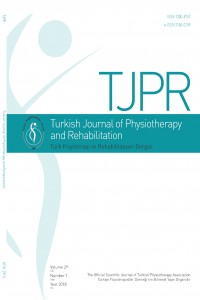Öz
Purpose: Increased fat mass and decreased muscle mass affect patient’s motor performance during slowly progressive neuromuscular diseases (NMDs). The purpose of this study was to investigate the effects of body composition on motor performance in adult patients with NMDs.
Methods: Twenty-six patients and 26 age-matched healthy participants were included in this cross-sectional study. Body composition was assessed using a bioelectrical impedance analyzer, and the motor performance was determined using a manual muscle testing, and timed performance was evaluated using climbing ten stairs, walking 10 m, wearing a t-shirt, supine up tests, and functional level using Motor Function Measurement (MFM) scale.
Results: There was no difference between the patients and the controls in terms of age, height, weight, and body composition (p>0.05). There was no correlation between body composition and timed performance tests for controls. In patients, the body mass index (BMI), fat mass (FM), and fat percentage (%FM) were correlated with the time of climbing 10 stairs (r=0.631, r=0.693, r=0.718, respectively) and supine up time (r=0.493, r=0.643, r=0.621, respectively) (p<0.05). Ten meter walking time was correlated with %FM (r=0.496) and fat free mass (r=-0.475, p<0.05). The MFM score was related with BMI (r=-0.425), FM (r=-0.503) and %FM (r=-0.586, p<0.05). Total lower extremity muscle strength was correlated with FM (r=-0.456) and %FM (r=-0.550) in patients (p<0.05).
Conclusion: The results of the study showed that body composition might be a factor affecting motor performance in adult patients with NMDs. Preventive strategies should be considered from the early stages of the disease.
Anahtar Kelimeler
Kaynakça
- 1. Kilmer DD, Zhao HH. Obesity, physical activity, and the metabolic syndrome in adult neuromuscular disease. Phys Med Rehabil Clin N Am. 2005;16(4):1053-62.
- 2. McCrory MA, Kim H-R, Wright NC, Lovelady CA, Aitkens S, Kilmer DD. Energy expenditure, physical activity, and body composition of ambulatory adults with hereditary neuromuscular disease. Am J Clin Nutr. 1998;67(6):1162-9.
- 3. Weil E, Wachterman M, McCarthy EP, Davis RB, O’day B, Iezzoni LI, et al. Obesity among adults with disabling conditions. JAMA. 2002;288(10):1265-8.
- 4. Zoico E, Di Francesco V, Guralnik J, Mazzali G, Bortolani A, Guariento S, et al. Physical disability and muscular strength in relation to obesity and different body composition indexes in a sample of healthy elderly women. Int J Obes Relat Met Disord. 2004;28(2):234-41.
- 5. Simoes EJ, Kobau R, Kapp J, Waterman B, Mokdad A, Anderson L. Associations of physical activity and body mass index with activities of daily living in older adults. J Community Health. 2006;31(6):453-67.
- 6. Erselcan T, Candan F, Saruhan S, Ayca T. Comparison of body composition analysis methods in clinical routine. Ann Nutr Metab. 2000;44(5-6):243-8.
- 7. Sedehizadeh S, Brook JD, Maddison P. Body composition and clinical outcome measures in patients with myotonic dystrophy type 1. Neuromuscul Disord. 2017;27(3):286-9.
- 8. Miscione MT, Bruno F, Ripamonti C, Nervuti G, Orsini R, Faldini C, et al. Body composition, muscle strength, and physical function of patients with Bethlem myopathy and Ullrich congenital muscular dystrophy. Sci Word Jo. 2013;2013:152684.
- 9. Vohra RS, Lott D, Mathur S, Senesac C, Deol J, Germain S, et al. Magnetic resonance assessment of hypertrophic and pseudo-hypertrophic changes in lower leg muscles of boys with Duchenne muscular dystrophy and their relationship to functional measurements. PloS One. 2015;10(6):e0128915.
- 10. Kyle UG, Bosaeus I, De Lorenzo AD, Deurenberg P, Elia M, Gómez JM, et al. Bioelectrical impedance analysis—part I: review of principles and methods. Clin Nutr. 2004;23(5):1226-43.
- 11. World Health Organization. Obesity: preventing and managing the global epidemic. (WHO) Technical Report Series 894. Geneva: WHO. 2000.
- 12. Kendall FP, McCreary EK. Muscles, testing and function. Brit J Sports Med. 1984;18(1):25.
- 13. Bushby K, Finkel R, Birnkrant DJ, Case LE, Clemens PR, Cripe L, et al. Diagnosis and management of Duchenne muscular dystrophy, part 1: diagnosis, and pharmacological and psychosocial management. Lancet Neurol. 2010;9(1):77-93.
- 14. İnal HS, Tarakçi E, Tarakçi D, Aksoy G, Kiliç SM, Beşer H, et al. Turkish version of the Motor Function Measure Scale (MFM-32) for neuromuscular diseases: a cross-cultural adaptation, reliability, and validity study. Turk J Med Sci. 2017;47(6):1826-33.
- 15. Lemos T, Gallagher D. Current body composition measurement techniques. Curr Opin Endocrinol Diabetes Obes. 2017;24(5):310-4.
- 16. Thomson R, Brinkworth GD, Buckley JD, Noakes M, Clifton PM. Good agreement between bioelectrical impedance and dual-energy X-ray absorptiometry for estimating changes in body composition during weight loss in overweight young women. Clin Nutr. 2007;26(6):771- 7.
- 17. St-Onge M-P, Gallagher D. Body composition changes with aging: the cause or the result of alterations in metabolic rate and macronutrient oxidation? Nutrition. 2010;26(2):152-5.
- 18. Jiang Y, Zhang Y, Jin M, Gu Z, Pei Y, Meng P. Aged-related changes in body composition and association between body composition with bone mass density by body mass index in Chinese Han men over 50-year-old. PloS One. 2015;10(6):e0130400.
- 19. McDonald CM, Carter GT, Abresch RT, Widman L, Styne DM, Warden N, et al. Body composition and water compartment measurements in boys with Duchenne muscular dystrophy. Am J Phys Med Rehabil. 2005;84(7):483-91.
- 20. Mok E, Béghin L, Gachon P, Daubrosse C, Fontan J-E, Cuisset J-M, et al. Estimating body composition in children with Duchenne muscular dystrophy: comparison of bioelectrical impedance analysis and skinfold- thickness measurement. Am J Clin Nutr. 2006;83(1):65-9.
- 21. Zanardi M, Tagliabue A, Orcesi S, Berardinelli A, Uggetti C, Pichiecchio A. Body composition and energy expenditure in Duchenne muscular dystrophy. Eur J Clin Nutr. 2003;57(2):273-8. 22. Oksuz C, Kilinc M, Yildirim SA. Predictors of health-related quality of life in adult ambulatory independence neuromuscular disease patients. Neurosciences (Riyadh). 2009;14(4):355-9.
Ayrıntılar
| Birincil Dil | İngilizce |
|---|---|
| Bölüm | Makaleler |
| Yazarlar | |
| Yayımlanma Tarihi | 24 Nisan 2018 |
| Yayımlandığı Sayı | Yıl 2018 Cilt: 29 Sayı: 1 |


